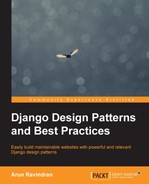In this chapter, we will discuss the following topics:
- Picking a web stack
- Hosting approaches
- Deployment tools
- Monitoring
- Performance tips
So, you have developed and tested a fully functional web application in Django. Deploying this application can involve a diverse set of activities from choosing your hosting provider to performing installations. Even more challenging could be the tasks of maintaining a production site working without interruptions and handling unexpected bursts in traffic.
The discipline of system administration is vast. Hence, this chapter will cover a lot of ground. However, given the limited space, we will attempt to familiarize you with the various aspects of building a production environment.
Although, most of us intuitively understand what a production environment is, it is worthwhile to clarify what it really means. A production environment is simply one where end users use your application. It should be available, resilient, secure, responsive, and must have abundant capacity for current (and future) needs.
Unlike a development environment, the chance of real business damage due to any issues in a production environment is high. Hence, before moving to production, the code is moved to various testing and acceptance environments in order to get rid of as many bugs as possible. For easy traceability, every change made to the production environment must be tracked, documented, and made accessible to everyone in the team.
As an upshot, there must be no development performed directly on the production environment. In fact, there is no need to install development tools, such as a compiler or debugger in production. The presence of any additional software increases the attack surface of your site and could pose a security risk.
Most web applications are deployed on sites with extremely low downtime, say, large data centers running 24/7/365. By designing for failure, even if an internal component fails, there is enough redundancy to prevent the entire system crashing. This concept of avoiding a single point of failure (SPOF) can be applied at every level—hardware or software.
Hence, it is crucial which collection of software you choose to run in your production environment.
So far, we have not discussed the stack on which your application will be running on. Even though we are talking about it at the very end, it is best not to postpone such decisions to the later stages of the application lifecycle. Ideally, your development environment must be as close as possible to the production environment to avoid the "but it works on my machine" argument.
By a web stack, we refer to the set of technologies that are used to build a web application. It is usually depicted as a series of components, such as OS, database, and web server, all piled on top of one another. Hence, it is referred to as a stack.
We will mainly focus on open source solutions here because they are widely used. However, various commercial applications can also be used if they are more suited to your needs.
A production Django web stack is built using several kinds of application (or layers, depending on your terminology). While constructing your web stack, some of the choices you might need to make are as follows:
- Which OS and distribution? For example: Debian, Red Hat, or OpenBSD.
- Which WSGI server? For example: Gunicorn, uWSGI.
- Which web server? For example: Apache, Nginx.
- Which database? For example: PostgreSQL, MySQL, or Redis.
- Which caching system? For example: Memcached, Redis.
- Which process control and monitoring system? For example: Upstart, Systemd, or Supervisord.
- How to store static media? For example: Amazon S3, CloudFront.
There could be several more, and these choices are not mutually exclusive either. Some use several of these applications in tandem. For example, username availability might be looked up on Redis, while the primary database might be PostgreSQL.
There is no 'one size fits all' answer when it comes to selecting your stack. Different components have different strengths and weaknesses. Choose them only after careful consideration and testing. For instance, you might have heard that Nginx is a popular choice for a web server, but you might actually need Apache's rich ecosystem of modules or options.
Sometimes, the selection of the stack is based on various non-technical reasons. Your organization might have standardized on a particular operating system, say, Debian for all its servers. Or your cloud hosting provider might support only a limited set of stacks.
Hence, how you choose to host your Django application is one of the key factors in determining your production setup.
